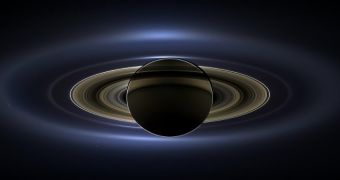Astronomers at NASA unveiled a new space image on Tuesday, November 12, showcasing the gas giant Saturn eclipsing the Sun. What is so special about this photo is that it also depicts three of the rocky inner planes in the solar system – Mars, Earth and Venus. This is the first time such a composite image was created.
Scientists operating the NASA Cassini spacecraft say that they have used 141 wide-angle images to create this breathtaking panorama, which covers a stretch of Saturn's surroundings around 404,880 miles. In addition to planets, it also includes many of the gas giant's moon.
The image appears as it would be seen by a human eye located at that very spot. It includes all but one of Saturn's rings. It would have been impossible for Cassini to image all rings considering that the planet's outermost ice circle is much wider than any of the others.
The mosaic, which is a part of the “Wave at Saturn” campaign, reveals Earth as a tiny and bright blue dot to the lower right of the gas giant, while Venus appears as a similar dot in the planet's upper left. Mars is somewhat fainter in appearance, and can be see above and to the left of Venus.
“In this one magnificent view, Cassini has delivered to us a universe of marvels. And it did so on a day people all over the world, in unison, smiled in celebration at the sheer joy of being alive on a pale blue dot,” says scientist Carolyn Porco.
Porco holds an appointment as the leader of Cassini's imaging team, and is based at the Space Science Institute in Boulder, Colorado. She says that no less than seven of Saturn's moons are visible in the new image, including the ice-spewing Enceladus.
“This mosaic provides a remarkable amount of high-quality data on Saturn’s diffuse rings, revealing all sorts of intriguing structures we are currently trying to understand. The E ring in particular shows patterns that likely reflect disturbances from such diverse sources as sunlight and Enceladus’ gravity,” scientist Matt Hedman says.
The expert is a Cassini participating scientist at the University of Idaho. The spacecraft will continue to orbit Saturn and image the gas giant, its moons and its rings until at least 2017, exceeding its original mission by several years.
Cassini is managed by the Jet Propulsion Laboratory at the California Institute of Technology for NASA's Science Mission Directorate, in Washington DC.

 14 DAY TRIAL //
14 DAY TRIAL //